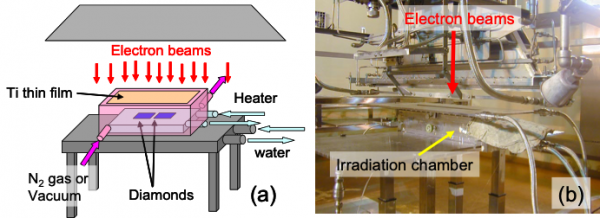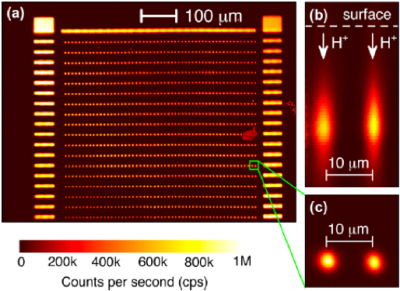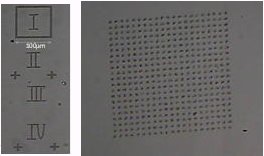Electron accelerator
It is a Cockcroft-Walton type electron beam accelerator, and the acceleration energy is variable in the range of 0.5 to 2 MeV. By scanning 120cm wide, it is possible to irradiate the electron beam uniformly. The beam current is often selected in the range of about 0.5 to 10mA, and if the current is lowered, the irradiation amount per beam will be 1x1011 electrons/cm2. If the current is increased, the irradiation amount will be about 1x1017 electrons/cm2 per one day. For an electron beam of 2 MeV, the electron beam will penetrate a diamond. The irradiated electrons eject the carbon atoms that make up the diamond, forming atomic vacancies. When a diamond containing nitrogen (P1 center) is irradiated with an electron beam, nitrogen and atomic vacancies are created in the crystal. When heat treated after irradiation, nitrogen (N) and atomic vacancies (V) combine to form NV centers.

Fig. Diagrams and photos of electron beam irradiation equipment
Ion accelerator
Test bench (~10 keV)
This picture shows a device for implanting ions into extremely shallow areas (10 nm or less) on the sample surface. The ion beam from the ECR ion source can be extracted at a low acceleration voltage of 1 to 10 kV, and the ion beam can be irradiated after mass spectrometry. XY beam scanner enables a uniform beam. The irradiation area is approximately 1.5cm x 1.5cm. 14N+ and 15N+ ions can be implanted. Irradiation is possible with a wide range of fluences from 108 ions/cm2 to 1014 ions/cm2. We can perform injection experiments with up to 4 conditions in one day.

Fig. Test bench
Ion implanter (20-400 keV)
This shows a device for implanting ions into a shallow region (10 to several 100 nm) of the sample surface. It is possible to heat the sample to a high temperature (~1000˚C), allowing implantation with less radiation damage than normal room temperature ion implantation. We can obtain uniform beam irradiation by using the XY beam scanner. For diamond samples, 15N+ ions, 15N2+ ions (molecular ions), 28Si+ ions, etc. are implanted at room temperature. Additionally, 31P+ ions, 27Al+ ions, etc. are implanted into silicon carbide samples. In 2019, we successfully demonstrated triple NV center fabrication as the three-qubits system (M. Haruyama, S. Onoda, et al., Nature Communications, DOI: 10.1038/s41467-019-10529-x ). This is based on a technology that uses an ion implanter to implant an ion beam of organic compound ions (C5N4Hn) containing multiple nitrogen atoms.

Fig. Vacuum chamber of ion implanter

Fig. Sample holder heated to 800℃
Single-ended accelerator (0.5-3 MeV)
We can perform particle beam writing using a focused ion beam of light elements (H, He). After determining the irradiation position using an optical microscope equipped with a long focal length lens, we can control the irradiation with a positional accuracy of 12 nm (however, the ion beam diameter (FWHM: half width) was around 1 µm) within the irradiation area = 800 x 800 µm2. Ion irradiation dose can be controlled from 1010 to 1017 ions/cm2.

Fig. Confocal microscope image of silicon vacancies formed by particle beam lithography
using an H (proton) beam on a silicon carbide substrate
(T. Ohshima, et al., Nano Lett. 2017).
Tandem accelerator (1-18 MeV)
This device is capable of implanting ions to a depth of several micrometers from the sample surface. We can successfully focus the ion beam to a few micrometers, which is called a micro beam line. By appropriately selecting the chopper pulse, it is possible to perform stochastic single ion hit irradiation. Within the irradiation range of 300 x 300 µm2, it is possible to irradiate the targeted position with ions while controlling the number of ions. The figure shows an example of drawing Roman numerals and grids on CR-39 (plastic track detector) using a microbeam. (As of May 2023: Injection experiments are suspended due to overhaul.)

Fig. The microbeam irradiation device

Fig. The drawing of heavy ion microbeam on CR-39
AVF cyclotron accelerator (several 100 MeV)
This allows ions to be implanted deep into the sample (several tens of micrometers). It is possible to irradiate ions with various ion types and linear energies, such as 15N3+ 56 MeV, 20Ne4+ 75 MeV, 40Ar8+ 150 MeV, 84Kr17+ 322 MeV, 129Xe25+ 454 MeV, and 192Os30+ 490 MeV.

Fig. Vacuum chamber
